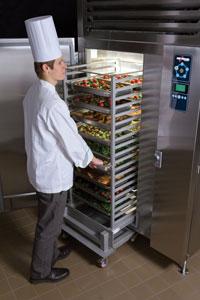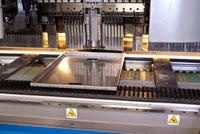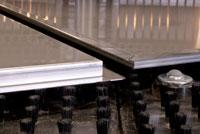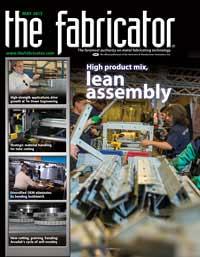Editor-in-Chief
- FMA
- The Fabricator
- FABTECH
- Canadian Metalworking
Categories
- Additive Manufacturing
- Aluminum Welding
- Arc Welding
- Assembly and Joining
- Automation and Robotics
- Bending and Forming
- Consumables
- Cutting and Weld Prep
- Electric Vehicles
- En Español
- Finishing
- Hydroforming
- Laser Cutting
- Laser Welding
- Machining
- Manufacturing Software
- Materials Handling
- Metals/Materials
- Oxyfuel Cutting
- Plasma Cutting
- Power Tools
- Punching and Other Holemaking
- Roll Forming
- Safety
- Sawing
- Shearing
- Shop Management
- Testing and Measuring
- Tube and Pipe Fabrication
- Tube and Pipe Production
- Waterjet Cutting
Industry Directory
Webcasts
Podcasts
FAB 40
Advertise
Subscribe
Account Login
Search
Sick of setup time at the press brake
Food service equipment manufacturer finds bending productivity outside of a traditional press brake
- By Dan Davis
- May 2, 2013
- Article
- Bending and Forming

Figure 1: Alto-Shaam Inc. invented the cook-and-hold commercial oven, but over the past several decades its product lineup has expanded greatly to accommodate a variety of commercial appliances, including what the company calls a “cook/chill system,” which combines a blast chiller with an oven/warming cabinet.
Not all OEMs are created equal. Some live the life of a fabricating job shop even though they have dedicated product lines.
Alto-Shaam Inc., Menomonee Falls, Wis., is such an OEM. The company is the originator of the low-temperature cook-and-hold oven, a staple for any commercial kitchen that has to serve throngs of people. But the manufacturer isn’t making just that one commercial appliance; it’s now building convection ovens, combination oven/steamer units, holding cabinets, quick chillers, heated buffet servers, rotisseries, smokers, and fryers. That translates into several thousand SKUs of finished products, none of which are ordered in massive numbers (see Figure 1).
Alto-Shaam is an OEM with job shop pressures. Not only does it have to cope with a low-volume, high-mix production environment, it also operates within tight time frames—pledging to get finished product to customers within 21 calendar days or 15 business days.
Big Idea, Big Business, Big Bending
Like many job shops, Alto-Shaam began in a garage. Jerry Maahs had a chicken delivery franchise in the 1950s, and he knew there had to be a way for him to be able to deliver hot chicken meals in the middle of frigid Wisconsin winters. He consulted with a couple of engineers, and they developed a stainless steel box that used a thermal cable to heat the box’s contents. Soon after unveiling his heating devices to the world, Maahs was selling them to other franchisees.
In the following months the heating box concept was tweaked so that the equipment both cooked and held meat at a predetermined temperature. This new concept gradually caught on with cooking professionals as they recognized that the oven’s low-temperature cooking approach could help to deliver more flavorful meat and reduce shrinkage in meat cuts. By the mid-1960s, Maahs sold his restaurants and jumped into the commercial appliance market. Alto-Shaam Inc. was open for business.
From that garage, the company has grown into a modern-day manufacturer of highly desired commercial appliances sold all over the world. It has two manufacturing plants in Menomonee Falls with a combined 350,000 square feet of manufacturing space, and it employs 400 people who work four 10-hour shifts. It also has facilities in Canada, France, Germany, and China and has distributors in more than 50 other countries.
Because of the global demand for its products, the manufacturer goes through several tons of sheet metal—primarily stainless steel in thicknesses between 20 and 18 gauge—per month. All blanks are laser-cut before heading to the bending value center.
More than two and a half years ago, that meant that the blanks often waited there before progressing on to welding and final assembly. This low-volume, high-mix manufacturer had a big bending bottleneck.
“The many non-value-added setups were causing us to lose our capacity very quickly, and bending became a major bottleneck,” said J.K. Raghavan, Alto-Shaam’s vice president, operations.
Throwing more press brakes at the problem didn’t make sense because that would require more operators and really wouldn’t achieve the goal of boosting press brake uptime. The 12 press brakes did a good job of bending; they just took too long to set up for the more than 9,000 parts that possibly could require bending.

Figure 2: The FastBend control software provides the operator with directions on how to manipulate the workpiece during bending. Once the instruction screen notifies the operator that tool setup is complete, the operator is asked to load the blank, reposition the part 90 or 180 degrees for subsequent bends, and unload the part. The operator doesn’t have to engage in any tool change or setup.
A Memory From FABTECH Past
At a FABTECH® tradeshow in Chicago several years before, Raghavan and his team recalled seeing an automated panel bender with full automation. The Express Bender from Prima Power had automated material handling, part manipulation, and tool changing—all very impressive, but more than Alto-Shaam needed. However, the idea of not having to worry about manual tool setup did stick with Raghavan.
So when Alto-Shaam was looking for assistance in trying to streamline its bending operation, it reached out to Prima Power to see if it had anything new to consider. In fact, the machine tool builder had just introduced its FastBend servo-electric bender.
The panel bender is similar to a press brake in the sense that it can tackle different bending jobs and shares a similar footprint. (Raghavan estimated that the panel bender’s footprint is about 20 percent larger than that of a traditional press brake.)
The big difference is that the panel bender helps to reduce setup time dramatically (see Figure 2). It can produce a wide variety of complex bends and forms with a standard set of tooling (see Figure 3).
When tooling does need to be changed, the automatic tool change option can lock new tooling into place in as few as 10 seconds, and the operator doesn’t have to get involved. Robotic units to the left and right of the bending bed place the tooling in the right place for the next job identified by the machine control software.
The FastBend operates much like its highly automated cousins. When in operating mode, the machine’s upper tool holds the sheet in position, and two blades mounted on a C frame manipulate the protruding sheet portion. The C frame can move vertically or horizontally with the help of two crankshafts and a connecting rod mechanism, which is managed by servo-electrical motors. These movements can result in negative (downward) and positive (upward) bends on the same blank without the need to turn it over during the entire bending sequence (see Figure 4).
Raghavan and his team recognized the panel bender as being the right complement to its bending operation. It would help to eliminate time-consuming press brake setups, increase uptime on the press brakes, and open the doors to more complexity in part designs.
The Results Are In
Since the equipment was installed, Alto-Shaam has reached a new level of production efficiency in its bending department. The bottleneck has disappeared.
“We increased our productivity by 250 percent,” said Raghavan. “For the same amount of time, we were able to produce 2.5 times more parts than with the press brakes. That is where eliminating setup was definitely bringing in the value we sought out.”
Alto-Shaam was able to accomplish this boost in bending productivity by taking a close look at which parts made sense for the panel bender and which made sense for the press brakes. Parts that required a lengthy amount of time to set up and large parts that might require two people to handle on a press brake went to the panel bender. Parts that had a setup of only two to three minutes or that were built routinely went to the press brake with dedicated tooling.

Figure 3: The panel bender has the capability to form different angles, hems, multiple corner radii, Z offsets, and closed tubular profiles with its standard set of tooling. No experienced bending operators are needed.
“We did our complete analysis, and we found out that about 50 to 65 percent of the parts that we produce were capable of being fabricated on the panel bender,” Raghavan said.
More specifically to setup times, operators are setting up the press brakes in, on average, half the time it used to require. Before the panel bender arrived, setup time on the press brakes was about 20 minutes. By sending more complex parts that required 30 or 40 minutes to set up to the panel bender and standardizing certain jobs for press brakes with dedicated tooling, the bending value center has reduced the average setup time to under 10 minutes.
“If you put it in perspective, since we acquired the panel bender, we continue to support business growth demands without adding capacity,” Raghavan said. “We haven’t added any press brake capacity. We actually have more capacity that we can use.”
Alto-Shaam plans to do just that. Engineers now have no qualms about moving ahead with difficult parts because the panel bender is able to tackle all jobs with ease. For instance, if a part design called for a curled profile, an experienced press brake operator would be needed to walk that piece of sheet metal through multiple hits as the brake bump-formed the curve. A panel bender can deliver a similar shape in less time and without producing scrap.
As proof of the quality improvements that the panel bender helps to deliver, Raghavan pointed to the company’s defects rate. At one time the defects per million opportunities rate was 1,700; today it is less than 700.
As with any continuous improvement journey, Alto-Shaam’s employees remain focused on eliminating waste in the company’s bending operations. It has additional capacity now, but if business continues to expand, that easily could set up the company to look at more bending equipment alternatives.
About the Author

Dan Davis
2135 Point Blvd.
Elgin, IL 60123
815-227-8281
Dan Davis is editor-in-chief of The Fabricator, the industry's most widely circulated metal fabricating magazine, and its sister publications, The Tube & Pipe Journal and The Welder. He has been with the publications since April 2002.
Related Companies
subscribe now

The Fabricator is North America's leading magazine for the metal forming and fabricating industry. The magazine delivers the news, technical articles, and case histories that enable fabricators to do their jobs more efficiently. The Fabricator has served the industry since 1970.
start your free subscription- Stay connected from anywhere

Easily access valuable industry resources now with full access to the digital edition of The Fabricator.

Easily access valuable industry resources now with full access to the digital edition of The Welder.

Easily access valuable industry resources now with full access to the digital edition of The Tube and Pipe Journal.
- Podcasting
- Podcast:
- The Fabricator Podcast
- Published:
- 04/16/2024
- Running Time:
- 63:29
In this episode of The Fabricator Podcast, Caleb Chamberlain, co-founder and CEO of OSH Cut, discusses his company’s...
- Trending Articles
How to set a press brake backgauge manually

Capturing, recording equipment inspection data for FMEA

Tips for creating sheet metal tubes with perforations

Are two heads better than one in fiber laser cutting?

Hypertherm Associates implements Rapyuta Robotics AMRs in warehouse

- Industry Events
16th Annual Safety Conference
- April 30 - May 1, 2024
- Elgin,
Pipe and Tube Conference
- May 21 - 22, 2024
- Omaha, NE
World-Class Roll Forming Workshop
- June 5 - 6, 2024
- Louisville, KY
Advanced Laser Application Workshop
- June 25 - 27, 2024
- Novi, MI



























